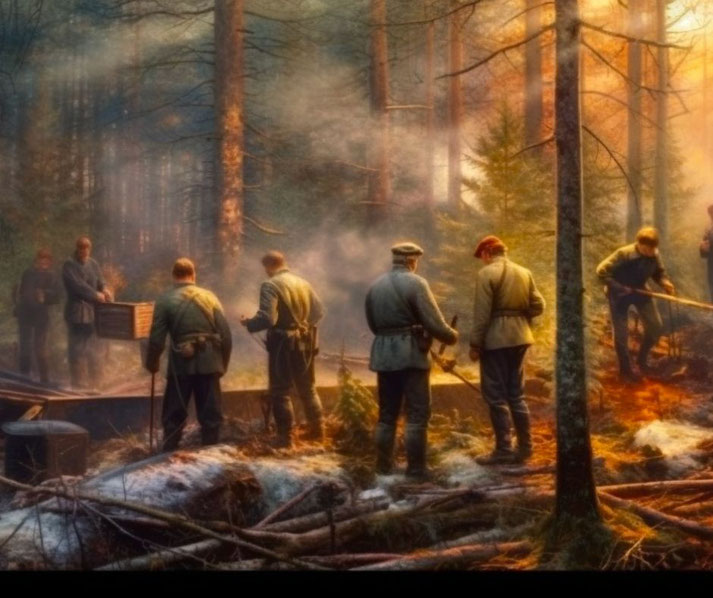Anastasia Romanov: The Russian princess who defied death?

The tragic tale of Anastasia Romanov, the youngest daughter of the last Tsar of Russia, Nicholas II, has captivated the world for over a century.
Born into a life of opulence and power, Anastasia's world was irrevocably shattered by the Russian Revolution of 1917. It led to the sudden abdication of her father and the eventual execution of her entire family by the Bolsheviks in 1918.
However, it is the mystery surrounding her alleged survival from the executioner's rifle that has transformed Anastasia's story from a historical tragedy into a historical detective story.
The tragic history of the Romanov family
The Romanov family ruled Russia for over three centuries, beginning in 1613 with Michael Romanov.
He was chosen as Tsar during a time of political instability and foreign invasion known as the "Time of Troubles."
Gradually, the Romanovs consolidated their dynastic power, transforming Russia from a fragmented and vulnerable nation into a formidable empire.
The most notable of the Romanov rulers was Peter the Great. He ascended the throne in 1682 and, through a series of ambitious reforms, modernized Russia.
Peter expanded the Russian territory, established the city of Saint Petersburg, and introduced sweeping changes in the military, government, and society as a whole.
The next significant Romanov ruler, Catherine the Great, continued this trend of modernization and expansion during her reign in the late 18th century.

However, the Romanov dynasty is perhaps best known for its last Tsar: Nicholas II.
Nicholas II took the throne in 1894, but is reign was punctuated by a series of national crises, including the disastrous Russo-Japanese War, the 1905 Revolution, and the catastrophic losses of World War I.
These events magnified Nicholas's inability to effectively address the nation's problems, which quickly led to widespread discontent.
In 1917, the mounting pressures exploded into the Russian Revolution. In February of that year, Nicholas II was forced to abdicate, which finally brought to an end more than 300 years of Romanov rule.
Consequently, the immediate royal family—Nicholas, his wife Alexandra, their five children Olga, Tatiana, Maria, Anastasia, and Alexei, and several loyal servants—were placed under house arrest.
Anastasia's care-free early life as a royal princess
Anastasia Nikolaevna Romanov, who was born on June 18, 1901, was the youngest daughter of Tsar Nicholas II and Tsarina Alexandra.
She was the fourth of five children, preceded by her sisters Olga, Tatiana, Maria, and followed by her brother Alexei.
Anastasia's life, like that of her siblings, was one of privilege and opulence. However, she also experienced the isolation that came with their royal status.
However, Anastasia was known for her vivacious and mischievous personality. She was often described as energetic, spirited, and a bit of a prankster.
This part of her character provided a much-needed levity to the family during stressful times.
Despite the grandeur of her royal status, Anastasia, like her siblings, her father made the effort to try and raise her without the pomp and ceremony typically associated with royalty.
The children were sometimes taught to sleep on hard cots, do chores, and respect all individuals, regardless of their social status.
However, Anastasia's upbringing was overshadowed by the political unrest that was brewing across Russia.
To many of the common people, the Romanov family was seen as being increasingly out of touch with the genuine hardships faced by the Russian people.
With each passing year, and with little change in royal attitudes to their predicament, general resentment towards them grew.
The situation was further complicated by the poor health of Anastasia's younger brother and heir to the throne, Alexei.
He suffered from hemophilia, a condition that was kept secret from the public, but was life-threatening.
The dramatic execution of her entire family
Following Nicholas II's abdication in 1917, the family was initially held in the Alexander Palace at Tsarskoye Selo, near Saint Petersburg.
However, as the Bolsheviks consolidated their power and the threat of counter-revolutionary forces loomed, the decision was made to move the family to a more secure location.
In August 1917, they were transferred to Tobolsk in Siberia, where they lived under house arrest in the former Governor's Mansion.
Then, in the spring of 1918, as anti-Bolshevik forces drew closer to Tobolsk, the family was moved again.
This time they were kept under guard to the Ipatiev House in Yekaterinburg, a city in the Ural Mountains.
The house was ominously renamed "The House of Special Purpose" by the Bolsheviks.
It was here, in the early hours of July 17, 1918, that the tragic end of the Romanov family unfolded.
The family was suddenly awakened and told to dress quickly as there was trouble in the town.
They were told that they needed to be moved for their safety.
Once in the house, they were led to a basement room, where they were informed that they were to awaiting transportation.
The room was ominously dark: only a single electric bulb hanging from the ceiling.
The family asked for chairs to be brought in so that Nicholas and Alexandra, and Alexei, who was unwell, could sit.
Moments later, a group of armed men led by Yakov Yurovsky, the head of the local Cheka (secret police), entered the room.
Yurovsky read out the execution order, stating that the Ural Soviet of Workers' Deputies had condemned them to death.
The family was in disbelief; Nicholas asked him to repeat the order. They barely had time to react before the room was filled with gunfire.
The execution was carried out in a chaotic and brutal manner. The initial hail of bullets did not kill all the family members, partly due to the jewels that had been sewn into the girls' clothing which acted as makeshift bulletproof vests.
The executioners then resorted to bayonets and close-range shots to kill them.
Then, the bodies were hastily buried in an unmarked grave in a nearby forest, where they would remain undiscovered for many years.

Did Anastasia manage to escape?
In the immediate aftermath of the execution of the Romanov family, the Bolsheviks maintained a veil of secrecy.
As a result, there was a lot of confusion and speculation about what had actually happened.
The initial reports suggested that Nicholas II had been executed but made no mention of his family.
This lack of information, coupled with the rumours that two bodies were missing, led to rumors that some of the Romanov children had survived.
The first claims of survival began to surface in the early 1920s. Several individuals came forward claiming to be the missing Romanovs.
Their stories fueled by the hope that a member of the royal family had escaped the brutal execution.
The most persistent of these claims centered around the Grand Duchess Anastasia, the youngest Romanov daughter.
The rumors were based upon the testimonies of several individuals who were involved in the execution or the disposal of the bodies.
Some claimed that the two missing the bodies had been burned and their remains buried separately from the others.
Others suggested that one or two of the Romanov children had been injured but not killed in the initial hail of gunfire.
For Russians who were loyal to the Romanovs and opposed to the Bolsheviks, the idea that Anastasia had survived offered a beacon of hope.
For others, the claims were seen as opportunistic attempts to exploit the chaos and uncertainty of the time for political advantage.
The people who have claimed to be Anastasia
In the years following the execution of the Romanov family, numerous individuals came forward claiming to be the missing Grand Duchess Anastasia.
These claimants, often referred to as "Anastasia imposters". The most famous of all these imposters was a woman named Anna Anderson.
In 1920, she was pulled from a canal in Berlin after a failed suicide attempt. When she recovered, she had no identification and refused to reveal her identity.
As a result, the hospital staff to call her "Fraulein Unbekannt" (Miss Unknown).
Two years later, she first claimed to be Anastasia Romanov. While she was not believed at first, Anderson's claim gained some credibility due to her knowledge of the Romanov family's private life and her potential resemblance to Anastasia.
Over the years, Anderson's claim was supported by some members of the Romanov extended family and their associates.
They began to believe that she was indeed Anastasia. However, many others, including Anastasia's tutor, Pierre Gilliard, and her aunt, Grand Duchess Olga, publicly stated that Anderson was an obvious imposter.
Despite these criticisms, Anderson stuck to her claim until her death in 1984.
Other notable Anastasia claimants include Nadezhda Ivanovna Vasilyeva, who surfaced in the 1920s in Russia, and Eugenia Smith, an American woman who published an autobiography in the 1960s claiming to be Anastasia.
Like Anderson, these women attracted a mix of believers and skeptics, but none were able to provide definitive proof of their identity.

The discovery of the Romanov's grave and DNA testing
The mystery of Anastasia Romanov's survival persisted for decades, mainly because of the absence of definitive proof of her death.
However, the advent of modern forensic science in the late 20th century brought new tools to bear on the question of Anastasia's fate.
The first major breakthrough came in 1991, when a mass grave was discovered in the vicinity of Yekaterinburg: the very city where the Romanov family had been executed.
The grave in question contained nine bodies. This complicated matters, as the Romanov family had been made up of seven members.
However, there were four servants killed with them, which meant that two bodies were missing.
Forensic scientists used a variety of techniques, including facial reconstruction and comparison of old injuries, to try and positively identify the bodies.
After many tests, they concluded that the bodies were indeed those of the Romanov family and their servants.
But the two missing bodies still led to speculation that Anastasia and her brother Alexei may have survived.
In an attempt to put these speculations to rest, DNA testing was conducted on the remains.
The tests, which compared the DNA from the remains to that of living relatives of the Romanovs, confirmed that the bodies were indeed those of the Romanov family.
The final piece of the puzzle fell into place in 2007, when a second grave was discovered near the first one.
This grave contained the remains of two individuals, a young woman and a boy, of the right ages to be Anastasia and Alexei.
DNA testing confirmed that these were the missing Romanov children, effectively ending the speculation about their survival.
In addition to the DNA testing of the Romanov remains, tests were also conducted on Anna Anderson, the most famous Anastasia imposter.
After her death in 1984, tissue samples that had been stored in a hospital were tested.
The results showed that Anderson's DNA did not match that of the Romanovs.
As a result, these scientific investigations and DNA evidence have provided the most compelling answers to the question of Anastasia's survival.
They have effectively debunked the remaining claims of the imposters and confirmed the tragic fate of the Romanov family.
What do you need help with?
Download ready-to-use digital learning resources
Copyright © History Skills 2014-2024.
Contact via email
With the exception of links to external sites, some historical sources and extracts from specific publications, all content on this website is copyrighted by History Skills. This content may not be copied, republished or redistributed without written permission from the website creator. Please use the Contact page to obtain relevant permission.





